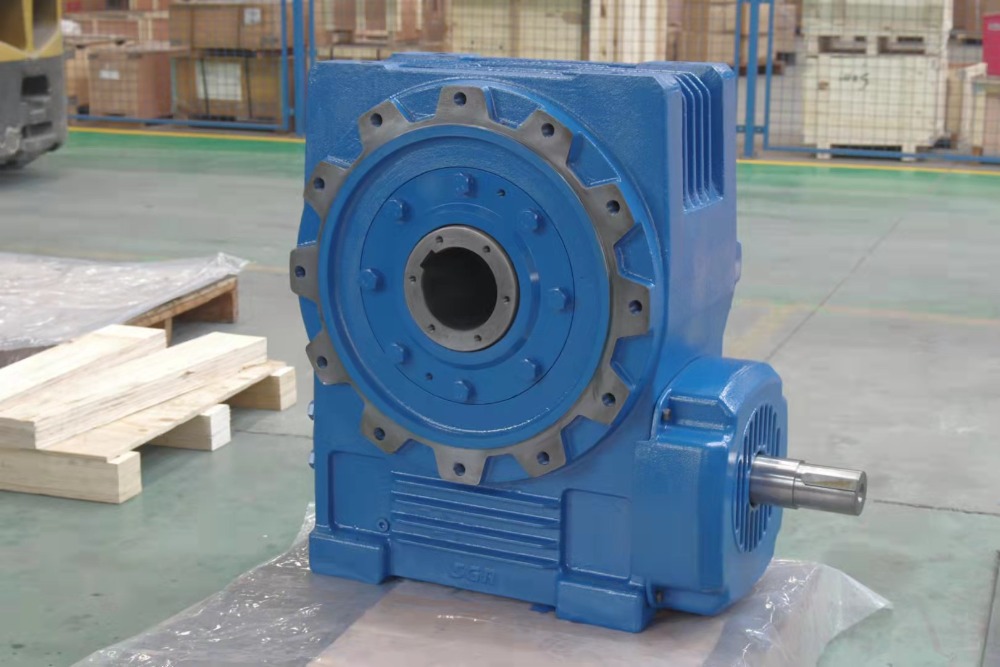SGR's N Series high torque coaxial planetary gearbox Input forms: N standard shaft input, MN flange ...
See DetailsThe worm gear reducer is a mechanical transmission device with a compact structure, a large transmission ratio, and a self-locking function under certain conditions. It is one of the emerging and most commonly used reducers.
Worm gear reducers are also one of SGR's core products. SGR, in collaboration with relevant universities, has developed China's first toroidal worm precision tester. The company has also conducted systematic research on the design, process, production, assembly, and testing of worm gear reducers, achieving research results that are both domestically and internationally advanced.

Currently, SGR mainly focuses on the research and development and production of worm gear reducers. So, what are some common problems that arise during the operation of worm gear reducers? How can these problems be resolved?
The worm gear reducer adopts sliding friction transmission. During the meshing process of the worm wheel and worm, especially when overloaded, the increased friction will cause the temperature to rise, resulting in differences in thermal expansion between the various parts and seals of the worm gear reducer, thereby generating gaps between the mating surfaces. The oil becomes thinner due to the increase in temperature, which can easily cause leakage.
In addition, due to aging of seals, improper installation or damage to the housing, oil leakage of the worm gear reducer may also occur.
Solutions: It is recommended to choose a worm gear reducer from a manufacturer with a good reputation before purchasing, which can ensure the surface quality of the meshing friction surface of the worm gear reducer is good; it is also recommended to pay attention to the selection of lubricating oil, and regularly add or replace the lubricating oil according to the instruction manual provided by the manufacturer; in addition, the working status of the worm gear reducer should be checked regularly to ensure that its load does not exceed the rated value, and aging sealing rings, gaskets and other seals should be checked and replaced in time to ensure a good sealing effect.
In worm gear reducers, the worm wheel is generally made of high-performance alloy bronze, and the paired worm material is usually hardened to a tooth surface hardness of HRC 58-62. Sometimes the worm wheel is also made of tin bronze, and the paired worm material is generally made of 45 steel hardened to HRC 45-55, or the worm material is 40Cr hardened to HRC 50-55.
When the worm gear reducer is operating normally, the worm acts like a hardened "file", constantly filing the worm wheel, causing wear on the worm wheel. Generally speaking, this wear is very slow, and most reducers can be used for more than 10 years.
If the worm gear wears quickly, it may be due to improper selection of the reducer, overload, or poor material, assembly quality or use environment of the worm gear. In serious cases, it may affect the efficiency and stability of the entire transmission system.
Solutions: Before purchasing, consider reducer manufacturers that use worm gears with excellent wear resistance, such as high-hardness alloy steel or high-performance alloy bronze. Ensure the use of high-quality lubricants and replace them at the manufacturer's recommended intervals to reduce wear. Additionally, regularly check the worm gear meshing to ensure there is no offset or misalignment. Any anomalies should be adjusted or repaired promptly.
When a worm gear reducer fails, even if the reduction box is well sealed, it will be found that the gear oil in the reducer has been emulsified and the bearings have been rusted, corroded, and damaged.
Worm bearing damage not only affects the normal operation of the worm gear reducer, but may also cause more serious failures. Bearing damage can be caused by a variety of reasons, including but not limited to improper installation, insufficient lubrication, overload, and foreign matter entering the bearing.
Solutions: It is recommended to strictly follow the operating procedures during the installation process to ensure that all parts are correctly installed and aligned to avoid unnecessary mechanical stress concentration. When assembling the output shaft, pay attention to the tolerance and ensure the assembly quality. It is recommended to check the status of the lubricating oil regularly to ensure that it is clean and free of impurities, and replenish or replace it as needed. When replacing gears, worm gears or damaged bearings, try to use original accessories.
Generally speaking, worm gear reducers are indispensable in industrial applications where high reduction ratios, compact design, and self-locking capability are required. However, their unique sliding friction transmission mechanism makes them inherently prone to challenges such as heat generation, oil leakage, worm wheel wear, and bearing failure—especially under improper operating conditions or inadequate maintenance.
At SGR, we address these challenges through a combination of advanced materials, precision manufacturing, and comprehensive quality control. Our worm gear reducers utilize 20CrMnTi alloy steel for worms and high-performance alloy bronze for worm wheels, both subjected to carburizing, quenching, and precision grinding to maximize surface hardness and wear resistance. The integration of our proprietary toroidal worm precision tester—the first of its kind in China—ensures optimal tooth profile accuracy and meshing quality, significantly reducing friction losses and thermal buildup.(Author,SGR, Angie Zhang)
WhatsApp: +86 188 1807 0282
Related Video Link:https://www.tiktok.com/@gear.reducer/video/7455630850676296991